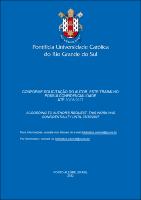| Share record |


|
Please use this identifier to cite or link to this item:
https://tede2.pucrs.br/tede2/handle/tede/10403| Document type: | Dissertação |
| Title: | Avaliação da espessura de esmalte de dentes anteriores em tomografia computadorizada cone-beam |
| Author: | Petracco, Laura Boianovsky  |
| Advisor: | Menezes, Luciane Macedo |
| Abstract (native): | Introdução: O desgaste interproximal (IPR) é um procedimento comum na prática ortodôntica. Uma questão importante ao realizar stripping, é estimar a quantidade de esmalte que pode ser removido. As diferenças individuais em relação a espessura de esmalte não podem ser subestimadas, uma vez que vários fatores, como grupo de dentes, superfície proximal, gênero e etnia são associadas a diferentes espessuras. Objetivos: Os objetivos desse estudo foram revisar as técnicas de desgaste interproximal e avaliar a espessura de esmalte de dentes humanos (incisivos centrais, incisivos laterais, caninos superiores e inferiores) em tomografias computadorizadas cone-beam (TCCB). Materiais e Métodos: Foram avaliados um total de 191 dentes, a partir de TCCB de alta qualidade, obtidas pelo tomógrafo PreXion 3D com FOV de 50x50mm e Voxel 0,10mm, solicitadas para fins de avaliação e tratamentos odontológicos diversos. Apenas dentes hígidos, sem a presença de desgaste incisal e de contenção ortodôntica foram selecionados para avaliação. Dentes restaurados, fraturados ou com anomalias de forma não foram incluídos na amostra. Resultados: Foi encontrada diferença estatisticamente significativa entre a espessura mesial e distal dos dentes, sendo que a superfície distal apresentou maior quantidade de esmalte (p=0,012). Não foi encontrada diferença estatisticamente significativa entre os dentes do lado direito e esquerdo e entre os dentes de homens e mulheres. Além disso, não foi encontrada correlação entre a espessura de esmalte e a idade dos pacientes. Porém, foi encontrada uma correlação em relação ao diâmetro mésio-distal dos dentes com a espessura de esmalte e com a forma dos dentes. Conclusões: As diferenças individuais em relação a espessura de esmalte devem ser consideradas, uma vez que vários fatores são associados a diferentes espessuras de esmalte. TCCB, radiografias periapicais e interproximais são ferramentas que devem ser utilizadas para mensuração das dimensões das coroas dentárias e espessura interproximal do esmalte. Com essa quantificação e mensuração pode-se evitar possíveis excessos de remoção de tecido, e pode-se planejar, com precisão, os locais e quantidade adequadas de desgaste para se obter resultados satisfatórios, com segurança. |
| Abstract (english): | Introduction: Interproximal reduction (IPR) is a common procedure in Orthodontics practice. When stripping is recommended, it is important to assess the amount of enamel that can be removed. Individual differences related to enamel thickness cannot be underestimated, since many factors such as group of teeth, proximal surface, gender and ethnic are related to different enamel thickness. Purpose: The aims of this study were to evaluate the enamel thickness of human teeth (upper and lower central incisors, lateral incisors and canines) in cone-beam computed tomography (CBCT) and to review interproximal reduction techniques. Material and methods: 191 teeth were evaluated in high quality CBCT obtained by the PreXion 3D with 50x50mm FOV and 0,10mm Voxel. The scans were requested for different types of dentistry treatments and for dental evaluation. Healthy teeth, without signs of incisal wear and the absence of orthodontic retainers were selected. Teeth with fillings and with anomalous form and size were excluded of the sample. Results: A statistically significant difference was found between mesial and distal enamel thickness. The distal surface presented a greater amount of enamel (p=0,012). No significant difference was found between the teeth of the right and left sides neither between gender. Besides, no correlation was found between the enamel thickness and the age of the patients. However, it was found a correlation between the mesiodistal width and the shape of the teeth, and between the mesiodistal width and the distal and mesial enamel thickness. Conclusions: The individual differences related to enamel thickness should be considered, since several factors are associated with different enamel thickness. Cone-beam computed tomography, periapical and interproximal radiographs are tools that should be used to measure dental crown dimensions and interproximal enamel thickness. With this quantification and measurements, orthodontists and clinicians are able to plan the appropriate sites and the amount of enamel wear to perform safely and obtain effective results. |
| Keywords: | Esmalte Dentário Desgaste dos Dentes Tomografia Computadorizada de Feixe Cônico Dental Enamel Tooth Wear Cone-Beam Computed Tomography |
| CNPQ Knowledge Areas: | CIENCIAS DA SAUDE::ODONTOLOGIA |
| Language: | por |
| Country: | Brasil |
| Publisher: | Pontifícia Universidade Católica do Rio Grande do Sul |
| Institution Acronym: | PUCRS |
| Department: | Escola de Ciências Saúde e da Vida |
| Program: | Programa de Pós-Graduação em Odontologia |
| Access type: | Acesso Aberto |
| Fulltext access restriction: | Trabalho será publicado como artigo ou livro |
| Time to release fulltext: | 60 meses |
| Date to release fulltext: | 30/08/2027 |
| URI: | https://tede2.pucrs.br/tede2/handle/tede/10403 |
| Issue Date: | 29-Mar-2021 |
| Appears in Collections: | Programa de Pós-Graduação em Odontologia |
Files in This Item:
| File | Description | Size | Format | |
|---|---|---|---|---|
| DIS_LAURA_BOIANOVSKY_PETRACCO_CONFIDENCIAL.pdf | LAURA_BOIANOVSKY_PETRACCO_DIS | 329.13 kB | Adobe PDF |  Download/Open Preview |
Items in DSpace are protected by copyright, with all rights reserved, unless otherwise indicated.




